kangaroos are hunted from the wild. This means that they forage for their own food, and do not need to be fed by humans. When they graze they eat from the tops of the plants, and do not destroy the roots of the plants which allow them to continue to grow unharmed.
About Me
Kangaroos are the largest of the forty-two different Australian macropods. Male red kangaroos, or boomers, are predominantly a red-brown color, measure about 9 feet from nose to tail and weigh 200 pounds. Female red kangaroos, or blue flyers, are smaller at about 6 feet and 90 pounds, and are generally a blue-gray color. It is not uncommon for a male to be gray, and a female to be red.
Kangaroos are extremely powerful animals. Sometimes male kangaroos will wrestle for fun, or over potential mates. This action is often referred to as “boxing”. The kangaroo is not actually able to make a fist. If they are able to get a hold of their opponent for balance, they will lean back on their tail and grab at each other with their hands, and then lift up their back feet and strike with their back feet. Kangaroos have a long tapered tail that assists them in walking, and as a rudder when hopping. A kangaroo may hop as fast as 35 mph, and at that speed they can cover 25 feet in a single bound. Their ability to travel long distances assists them in the hot and arid climate of the Outback with finding both food and water. They prefer to eat newly-green grasses and shrubs, therefore they must continually be on the move to find fresh resources.
Kangaroos are a marsupial. This means they have a partially developed live birth, and then the offspring continues to develop externally in the mother’s pouch where it will stay until it is fully developed. When a baby kangaroo is born, it is the size of a thumbnail. It then must crawl into the mother’s pouch where it will attach itself to a nipple. A baby kangaroo, or joey, stays in the pouch for 6-8 months before permanently emerging, but as they grow they will spend time outside of the pouch and dive back in when startled. After the kangaroo has outgrown the pouch they will fall out, but will continue to nurse from outside the pouch for another year. Kangaroos have the ability to become pregnant, but suspend the development of the embryo and keep it within the womb until the pouch is unoccupied. That means that a mother can be pregnant, have a baby in the pouch, and have a baby on the ground at the same time. Female kangaroos are able to produce different stages of milk simultaneously to accommodate both the offspring in the pouch and the one still nursing from outside the pouch. Their body makes colostrum milk for the newborn for up to 72 hours after birth, and regular milk for the baby that just exited the pouch.
Red kangaroos are abundant, and an iconic symbol of Australia. They are well suited to surviving on grasses, shrubs, and herbs. Due to the meager forage available in the Outback, kangaroos often travel long distances for food.
Kangaroos, the largest of the Australian macropods, are a large footed, plant eating, marsupial mammal. They live in the sparse and arid area of Australia called the Outback.
Snapshot
1. Baby kangaroo are called joeys
2. A group of kangaroo is called a mob
3. Kangaroo may become pregnant, but until the pouch is unoccupied, the embryo will stay in the body, undeveloped.
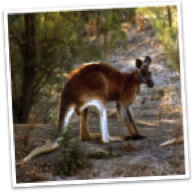
Name: Kangaroo
Scientific: Macropus rufus
Family: Macropodidae
Relatives: Wallaroo, Wallaby, Pademelon
Environment: Outback, Grassland
Origin: Australia
Life-span: 20 years
Size: 100 - 200 lbs






Fast Facts

Some consider kangaroos to provide environmentally-friendly meat because they are hunted in the wild, and do not require additional care.
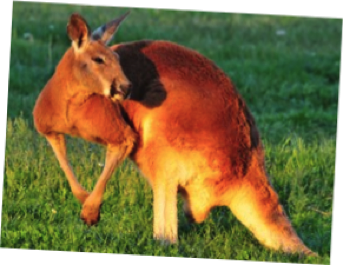
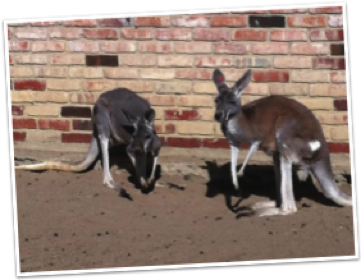

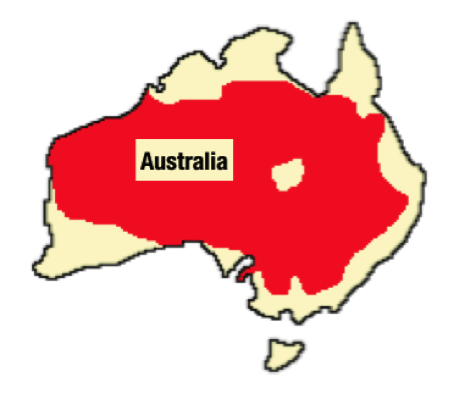
Products
• Meat
• Whips
• Hide/Leather
• Furnishings
Uses
Kangaroos are adapted to the drought-ridden environment of the Outback. They are so numerous that they have become an iconic symbol of Australia. Historically, kangaroos have been used for their hide and as a high protein and low fat meat source for the indigenous people. In recent years, farming kangaroos for meat has become more common. Some consider it an environmentally-friendly meat industry because


